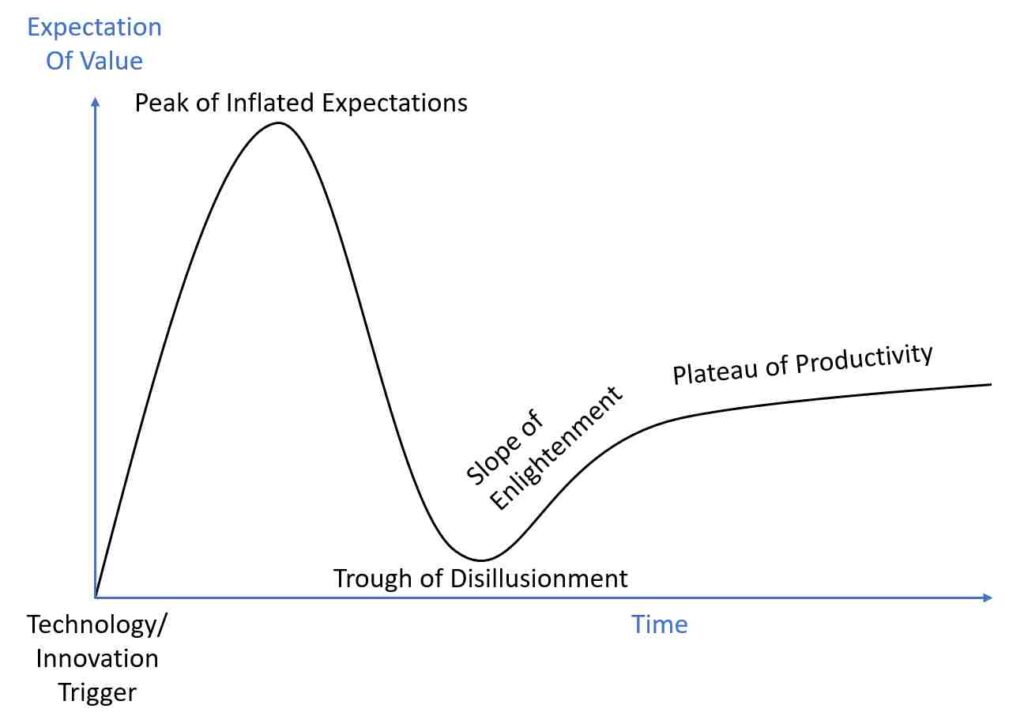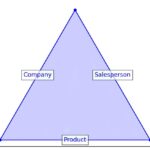When a breakthrough technology is introduced, it often feels like a revolution is at hand. The promises are big, the marketing even bigger. We’re told this new tool or innovation will change everything. And so, many of us—especially in small business—buy in early. We upgrade our systems, invest money and time, and tell ourselves we’re staying ahead of the curve.
But then reality hits.
The technology doesn’t work as smoothly as promised. It lacks the support ecosystem. Bugs emerge. Features are missing. Expectations aren’t just unmet—they’re shattered.
This isn’t new. It’s predictable.
It’s called the Gartner Hype Cycle, and it’s something every entrepreneur should understand—especially those prone to early adoption. In fact, we covered the full Gartner model in this companion post: How to Apply the Gartner Hype Cycle to Small Business. But here’s the short version:
The Five Stages of the Gartner Hype Cycle

- Innovation Trigger – A breakthrough or new concept gains attention.
- Peak of Inflated Expectations – The press and marketers build expectations beyond reality.
- Trough of Disillusionment – The first wave of users experiences real flaws.
- Slope of Enlightenment – The true value begins to emerge through iteration.
- Plateau of Productivity – The technology reaches mainstream adoption and delivers consistent results.
Let’s break it down with real-world examples and show how small businesses can apply this insight.
From Hype to Disappointment—and Eventually, Value
When HD TVs first came out, early adopters rushed to upgrade their old sets. But after spending hundreds (or thousands), they realized there was barely any HD content available. Their shiny new TVs looked only marginally better—if at all. This mismatch between expectation and reality caused frustration.
The same pattern occurred with WiFi. Laptops were upgraded, routers installed—but coverage was spotty and security was nearly nonexistent. Hacking became a concern, and early adopters questioned their choices. But then came encryption (WPA2, then WPA3), broader hotspot access, and better device compatibility. Today, WiFi is not just common—it’s expected.
This happens over and over.
Think about 3D printers, the metaverse, or electric vehicles. They all spark excitement, suffer from early shortcomings, and eventually find their rightful place.
Why the Hype Cycle Matters to Small Business
Small businesses tend to have limited capital and time. Chasing the latest tech can be tempting—it feels like a competitive edge—but it’s often a trap if you adopt too early. In How to Apply the Gartner Hype Cycle to Small Business, we explored how different types of business owners react at each stage:

- Innovators and early adopters are often risk-takers who jump in at the Peak of Inflated Expectations.
- Pragmatists and conservatives wait until the Plateau of Productivity, ensuring ROI and proven reliability.
- Laggards may never adopt, often due to skepticism or budget constraints.
If you’re a solopreneur or running a microbusiness, being strategic about timing is essential. Misreading where a tech sits on the curve could cost you precious resources.
Questions to Ask Before You Adopt
If you’re tempted to embrace a new tech solution, pause and ask:
- Where is this product on the hype cycle?
- Are there early case studies or success stories from businesses like mine?
- What support ecosystem (training, updates, integrations) is in place?
- Can I test this on a small scale before rolling it out fully?
- What are the opportunity costs if I adopt—or wait?
By slowing down and asking these questions, you give yourself permission to learn from others’ mistakes—without becoming one of them.
There’s No Shame in Waiting
In the startup world, “first mover advantage” is romanticized. But often it’s the fast follower who wins—the one who learns from the early adopters’ mistakes and enters the market with better timing and fewer bugs.
As a small business, you don’t have to be the first—you just have to be smart.
Let others deal with V1.0 glitches and marketing overpromises. Let the media fanfare settle. Once the tech has matured and clear use cases emerge, you can jump in with confidence and often for less cost.
Final Thoughts
Disruptive technologies almost always disappoint before they deliver. But understanding the hype cycle puts you in a position of strength. Instead of getting swept up in the excitement—or frozen by fear—you can make clear, calculated decisions.
Small business owners don’t need to chase every new thing. They just need to know when and how to say yes.
Are you currently evaluating a new technology? Where do you think it falls on the hype cycle?












